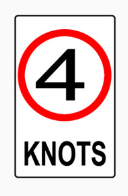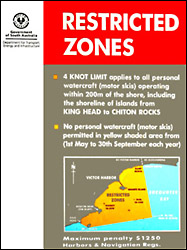Safe vessel speeds
Speed limits apply where high-speed boats may be a hazard to other water users. Various harbours, areas of the Port Adelaide River, metropolitan beaches and some country beaches, and sections of the River Murray are subject to speed limits.

A boat travelling at around 4 knots - equivalent to a fast walking pace
Judging a safe speed
All vessels must travel at a safe speed at all times. A safe speed gives you enough time to stop or turn your vessel to avoid any sudden danger, such as a collision, injury to people, or damage to things.
If you intend boating, waterskiing, or using a personal watercraft in unfamiliar areas, make sure you find out about any speed restrictions.
Where the waterway has no speed limit, you must always travel at a safe speed.
A safe speed depends on many variables. These include the conditions, time of day, type of vessel, and your experience driving it. As the skipper, a safe speed is something you must constantly judge and adjust as you travel.
When judging your vessel's speed, you must always consider these circumstances and conditions:
- visibility – for example, rain, fog, mist, smoke or glare
- other vessels – on busy waterways and near moored or anchored vessels, commercial vessels displaying special signals, and large vessels that are restricted in their manoeuvrability
- manoeuvrability of your vessel – in particular the distance it takes to stop or turn. Your manoeuvrability is affected by your speed, the wind and current, and the vessel's design.
- at night (between sunset and sunrise) – potential hazards may not be lit or easily seen. Background lights on the shore – or even lights on your own vessel – can make it hard to see other vessels.
- navigation hazards – such as unmarked or unlit hazards, and signs, buoys, marks or lights that have moved or been damaged.
- shallow water – water depth can vary and change frequently.
In these circumstances or conditions you may need to slow down to travel at a safe speed.
Speed limits
Some areas do have speed limits. Where there is a speed sign, you must not travel faster than the speed shown on the sign.
Even when there is a speed limit, you must always travel at a safe speed. This may mean going slower than the speed limit.
Speed limits are in knots. They are usually 4 or 7 knots, but can also be other speeds.
Comparing knots to land activities and other speed measurements

Speed limit sign (4 knots is about 7km/h or a fast walking speed)

Speed limit sign (7 knots is about 11km/h or a jogging speed)
Speed limits – sharing the water safely
A four-knot speed restriction applies:
- within 50 metres of
- a person in the water
- a vessel or buoy displaying a flag indicating that there is a diver below (international code flag A)
- a person in or on a canoe, kayak, surf-ski, surfboard, sailboard, or similar small unpowered recreational vessel
- within 30 metres of any other vessel, whether stationary or underway, that may be adversely affected by your wash
- within 100 metres of a ferry crossing on the River Murray
- within a mooring area or boat haven
- to waters within a number of marinas and restricted areas throughout South Australia - limits in such areas should be clearly signposted, but it is your responsibility to know the restrictions that apply wherever you go boating
- within 30 metres of a jetty, wharf, or other places at which a boat is being launched or retrieved.
A seven-knot speed restriction applies:
- In some aquatic reserves, harbours, and boat havens and will be indicated by signs ashore or on the water.
- In some parts of the Barker Inlet and North Arm of the Port River for the safety of all water users and marine life.
Port River speed limit map (PDF, 190.2 KB)
A ten-knot speed restriction applies:
- While a boat (not a personal watercraft) is being operated by an unlicensed person - minimum age 12 years with a licensed person in charge.
Similar speed restrictions also apply to many local areas. These restrictions are often detailed on signs located along the shoreline or near boat ramps.

Personal watercraft speed limits
A four-knot speed restriction also applies to all personal watercraft, (commonly known by their brand names such as - jet-ski and wave runner), within 200 metres of the metropolitan shoreline. This includes restrictions between Outer Harbor southern breakwater, the southern end of Sellicks Beach, and the backwaters of the River Murray - unless zoned otherwise.
Similar restrictions apply to beachfront areas on many popular swimming and tourist beaches. These areas are generally well signposted but check with the local council about speed restrictions that may apply wherever you intend to operate a personal watercraft.
Remember personal watercraft can only operate during these times:
- after 8:00 am from Monday to Saturday
- after 9:00 am on a Sunday
- until sunset or 8:00 pm on any day (whichever is earlier)
- at any time between sunrise and sunset on any day, on the River Murray when towing water skiers proving all water skiing rules are complied with.
Restricted areas
There are many areas along the South Australian coastline and inland waterways that have restrictions on the type of boating activities that can be carried out. Signs are in place to advise about restrictions. There are penalties if you do not observe the controls or speed restrictions provided on these signs.


